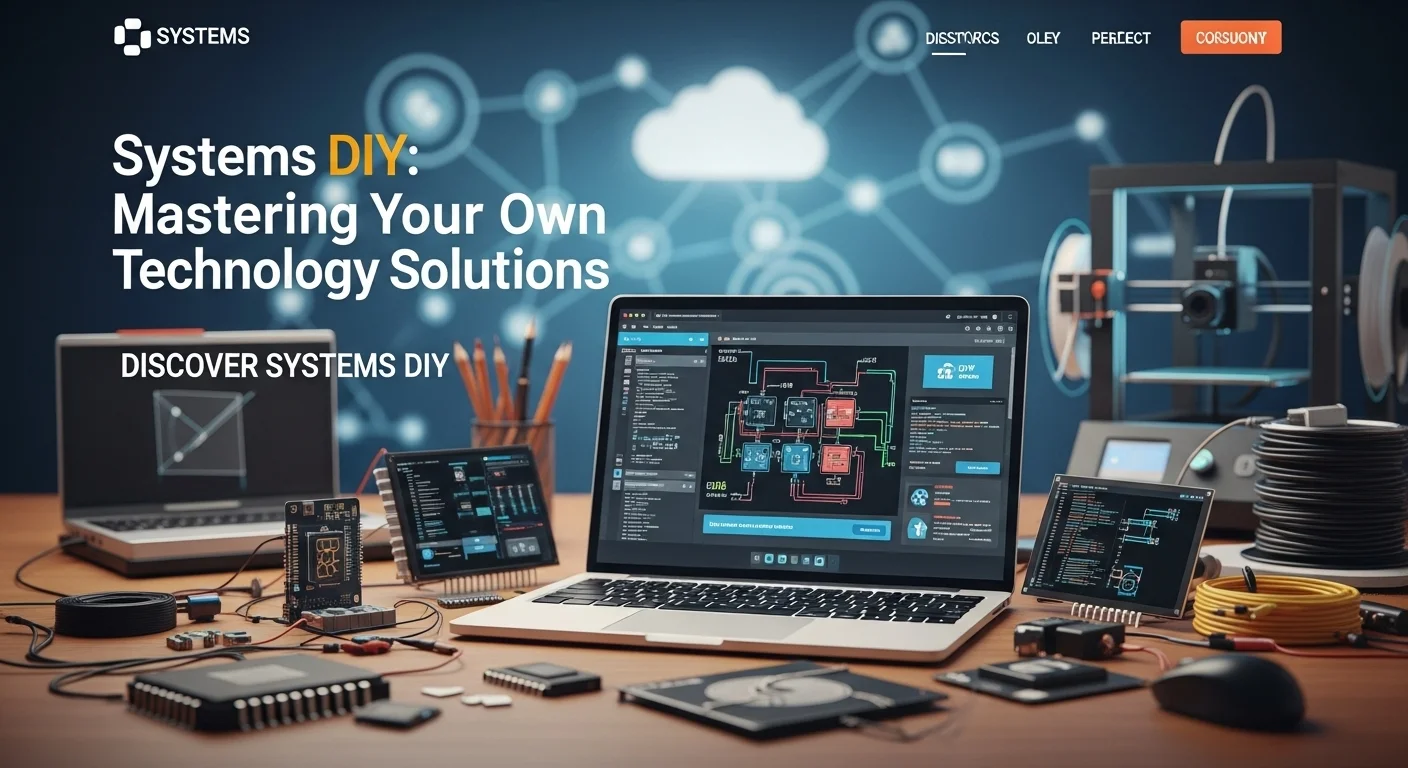DIY Tech Systems: My Guide to Building Custom Solutions for Home and Business

Executive Summary
In a world of locked-down gadgets and monthly subscriptions, I got tired of being just a consumer. The 'Do-it-Yourself' spirit, for me, wasn't about woodworking; it was about technology. It's a powerful movement that lets people like you and me take back control of our digital lives. I'm talking about Systems DIY—the art of building and managing your own tech solutions, from a truly smart home that values your privacy to a powerful, low-cost server for your small business. The benefits I've seen firsthand are huge: massive cost savings, systems tailored perfectly to my needs, and the peace of mind that comes with knowing my data is my own. For tech lovers, it’s a thrilling journey of learning. For a business, it’s a smart strategy to become more agile and independent. This article is my personal guide to this world. I'll walk you through how to stop being a passive user and start being the architect of your own technology.
Table of Contents
Table of Contents
- What Are DIY Tech Systems, and Why Do They Matter?
- The Real-World Power of DIY Tech for You and Your Business
- Bringing It Home: The Magic of a DIY Smart Home
- A Smarter, Safer Home: Integrating DIY Security
What Are DIY Tech Systems, and Why Do They Matter?
For me, the DIY bug didn't start with shelves or crafts; it started with technology that just wasn't doing what I needed it to do. That's the heart of 'Systems DIY.' It’s about stepping away from buying pre-packaged, restrictive products and instead, building your own tech solutions from the ground up. Think of it as cooking a meal from scratch versus buying a frozen dinner. You get to pick the ingredients (open-source software, modular hardware) and control the entire process. This isn't just a hobby for garage tinkerers anymore; it’s a full-blown movement that gives us incredible power over the technology we use every day, whether it's in our homes or powering a business.
At its core, this whole philosophy rests on three pillars I've come to rely on: openness, modularity, and control. The foundation is open-source software—code that's free, transparent, and constantly improved by a massive community. We're talking about legends like the Linux operating system or powerful tools you can find on GitHub. [3] Then you have the building blocks: modular hardware. The game-changer here has been single-board computers like the Raspberry Pi or microcontrollers like the Arduino. [14] These little devices are cheap, powerful, and let you build incredibly efficient, dedicated systems. The final and most important pillar is control. When you build it, you own it. You decide how it runs, what information it gathers, and who sees it. In an era where our privacy is constantly under threat from big tech's 'walled gardens,' this is more than an advantage—it's a necessity.
The Real-World Power of DIY Tech for You and Your Business
The impact of taking a DIY approach to tech is massive. It sparks so much creativity because it makes it cheap and easy to try new things. I've been able to spin up test servers and prototype ideas without spending a fortune. It’s this kind of grassroots innovation that often leads to amazing breakthroughs. For small and medium-sized businesses, the benefits are even more concrete. The most obvious one is saving money. [5] I've helped friends set up a custom file server using an old desktop and free software like TrueNAS, saving them thousands compared to a commercial unit. I've done the same with firewalls, using pfSense on basic hardware to get enterprise-level security for a tiny fraction of the cost. [8] But it's not just about the money. It's about getting a perfect fit. [2] Instead of changing your business to fit a piece of software, you build the system to fit your business. This makes a company so much more agile and able to scale. [6] Plus, you build valuable technical skills within your own team, making you less dependent on outside help.
Bringing It Home: The Magic of a DIY Smart Home
Nowhere is the DIY spirit more alive than in the smart home. Sure, you can buy into the ecosystems from Amazon, Google, or Apple, but I, like many others, found them limiting. That's why building your own home automation systems diy style has become so popular. The goal is simple: escape the corporate ecosystems, protect your privacy, and create a smart home where everything actually works together. [32] When you buy off the shelf, you often get devices that refuse to talk to each other. With a DIY approach, you build a central brain for your home that can speak every language—Zigbee, Z-Wave, Wi-Fi—and unite all your gadgets. This is where creating your own diy smart home systems becomes a game-changer, giving you a level of control you just can't buy.
My quest for the best diy home automation system led me, as it does for many, to platforms like Home Assistant and openHAB. [11, 13] These aren't products you buy; they're incredibly powerful software frameworks you install on your own hardware, like a cheap Raspberry Pi. I personally swear by Home Assistant. It has a huge, supportive community, works with thousands of devices, and has a clean interface. [10, 23] Most importantly, it puts 'local control' first. This means my smart home keeps working even if my internet is down, unlike many cloud-based systems. [32] This lets me create automations that feel like magic, like 'if the garage door is left open for 10 minutes after sunset, send a notification to my phone.' The journey to find the best diy smart home system isn't about buying one thing; it's about choosing a platform that lets you build a system that's truly yours and can evolve with you.
A Smarter, Safer Home: Integrating DIY Security
Security is the natural next step for any smart home, and building an integrated diy home automation and security system is one of the biggest wins of this approach. Forget expensive monthly monitoring fees. [21, 31] The same sensor that turns on a light when you enter a room can trigger an alarm if you're not home. [33] A simple motion sensor can become a silent guardian. With a DIY system, I was able to set up my own cameras that store all their footage on my own local server, not some company's cloud. This was a huge deal for my family's privacy. [37] I've even dabbled with open-source AI software like Frigate to teach my system to tell the difference between a person and a passing car, dramatically cutting down on false alarms. This blend of automation and security creates a home that doesn't just react; it anticipates. An alert that says, 'A person was detected on your back patio' is infinitely more powerful than a generic alarm, and it's why an integrated diy home automation and security system is, in my book, the only way to go.

My Step-by-Step Guide to DIY Tech for Your Home and Business
Getting started on a Systems DIY project, whether it's for your business or the ultimate smart home, can feel daunting. But trust me, it boils down to a simple process: pick the right tools, have a clear plan, and build it piece by piece. This guide is my personal walkthrough of the key components and strategies I use to build systems that are powerful, secure, and built to last. Let's dive in.
Choosing Your Foundation: Hardware and Software
The core of any DIY system is its hardware and software. This choice affects everything—power, cost, and what your system can ultimately do.
My Go-To Hardware:
- Single-Board Computers (SBCs): For most of my projects, especially for the brain of my home automation systems diy, the Raspberry Pi is my hero. [14] It’s cheap, tiny, sips power, and is more than powerful enough. Other options like an Odroid can give you a bit more muscle if you need it.
- Microcontrollers: For simple, specific jobs, I use microcontrollers like an ESP32 or Arduino. [14] These aren't full computers, but they're perfect for being the 'eyes and ears' of a project—reading a temperature sensor, controlling a light strip, and sending that data back to the main hub.
- Old & New Server Hardware: For bigger jobs, like a file server for my business or a media server for the family, I'm a big believer in repurposing. An old desktop computer can become an incredibly powerful server for almost no cost. When I needed more power, I built a custom server, hand-picking parts for efficiency and quiet operation.
My Software Stack:
- Operating System: Linux is the undisputed king here. I usually go with a lean version like Debian or Ubuntu Server. For my home server, which handles all my files and backups, I run TrueNAS. It's a specialized OS that makes managing storage and running apps in things like Docker incredibly simple.
- The Main App: This is the software that does the heavy lifting. For my diy smart home systems, it's Home Assistant, hands down. [11, 13] For a network firewall, I'd use pfSense. My rule of thumb is to always choose open-source software that has a big, active community behind it.
A Real-World Walkthrough: Building the Best DIY Home Automation System
Let's build what I consider the best diy home automation system, using Home Assistant on a Raspberry Pi. This is the perfect first project.
Step 1: Get Your Gear. You'll need a Raspberry Pi 4 or 5 kit (with power supply and SD card) and a Zigbee USB stick. This little stick is crucial—it's a radio that lets your hub talk directly to battery-powered sensors, which is way more reliable than Wi-Fi for this stuff.
Step 2: Install Home Assistant OS. This is easier than it sounds. The Raspberry Pi Imager tool lets you write the Home Assistant OS directly to the microSD card. It’s a super smooth process, no coding required. [10]
Step 3: First Boot and Discovery. Plug it in, and after a few minutes, you can access Home Assistant from a web browser on your network. A setup wizard will walk you through the basics. The cool part is that it will probably have already found a bunch of your smart devices on its own, like your TV or smart speakers.
Step 4: Add Your First Device. Plug in that Zigbee stick. In the Home Assistant settings, add the Zigbee integration. Now for the fun part: grab a Zigbee door sensor, put it in pairing mode, and watch it pop up in Home Assistant. You've just started building your own local device network, the foundation of all great diy smart home systems.
Step 5: Create Your First Automation. Here’s where the magic really happens. Using the simple visual editor, you can build a rule. For example:
- When... The door sensor opens.
- Only if... It's dark outside.
- Then... Turn on the living room light.
That simple logic is the key. You can expand on it to create incredibly powerful routines, which is why I believe this is the best diy smart home system—the only limit is your imagination.
Leveling Up: Your Integrated DIY Home Automation and Security System
Now, let's turn that smart home into a full-blown diy home automation and security system using the same tools.
- Add Security Sensors: Use the same types of door/window and motion sensors, but now they'll serve a dual purpose. [33]
- Install Local-First Cameras: I can't stress this enough: buy IP cameras that support standard protocols like RTSP. [37] This lets you bring them into Home Assistant without using the manufacturer's privacy-invading cloud. Your video footage stays on your hardware. With an add-on like Frigate, you can even do local AI detection to spot people or cars.
- Set Up a Security Panel: Home Assistant has a built-in alarm panel feature. You can set states like 'Armed Away' or 'Armed Home.' Then, you create rules based on these states. For instance, 'If motion is detected while Armed Away, sound a siren and send an emergency alert to my phone.'
- Secure Remote Access: To check on your home from anywhere, you need to do it safely. The easiest and most secure way is using Nabu Casa, a small monthly subscription from the Home Assistant developers that creates a secure link to your system. For advanced users, setting up your own VPN like WireGuard is another great option.
By following these steps, you'll have a security system that's more private, more powerful, and perfectly integrated with your smart home—proving that one DIY system can do the job of many commercial products, and do it better.

Lessons I've Learned: Tips and Strategies for a Better DIY Tech Experience
Getting your first DIY system up and running is an amazing feeling. But the real test of a great project—whether it's a server for your business or the brain of your smart home—is how it holds up over time. It needs to be reliable, secure, and easy to manage. This is about moving from the 'build' phase to the 'maintain' phase. Here are some of the most important lessons and strategies I've learned, often the hard way, to make sure my custom tech is a stable and secure part of my life.
My Golden Rules for Long-Term Stability
A system that works today but is a mystery tomorrow is a liability. To avoid future headaches, I live by these rules.
1. Document Everything. No, Really: I can't tell you how many times I've stared at a project six months later with zero memory of how I configured it. Don't be like me. Document your process. This includes:
- Your Parts List: Write down every piece of hardware and software, including version numbers.
- Save Your Configs: Keep copies of important configuration files. I use Git to track changes, which is a lifesaver.
- Map Your Network: A simple drawing of what's connected where, with IP addresses, is invaluable when something goes wrong.
- Write 'Future You' a Guide: Jot down simple, step-by-step instructions for tasks you'll need to do later, like updating an app or swapping a hard drive. You'll thank yourself later.
2. Have a Bulletproof Backup Strategy: Your data will be lost. It's not a question of 'if,' but 'when.' The 3-2-1 rule has never failed me: keep at least three copies of your data, on two different kinds of storage, with one copy stored somewhere else entirely. For my home automation systems diy setup, this looks like:
3. Update Wisely, Not Recklessly: It’s tempting to hit 'update' on everything immediately, but that's a recipe for disaster. My approach is to 'update with intent.' Before any major update, I read the release notes to see if there are any 'breaking changes.' If I can, I'll test the update on a backup system first. For truly critical systems, sticking with Long-Term Support (LTS) versions is often the smartest move for stability.
Advanced Strategies to Level Up Your DIY Game
Once your system is stable, it's time to unlock its true potential. This is where you can create something truly special, especially when building the best diy smart home system you can imagine.
1. Become an Automation Guru: The visual editors are great, but tools like Node-RED (a Home Assistant add-on) can take your diy smart home systems to another level. It’s a visual way to build incredibly complex automations that can handle almost any scenario you can dream up. For ultimate power, you can even write small Python scripts that interact directly with your system.
2. Use AI Without Sacrificing Privacy: Local AI is one of the most exciting frontiers in DIY tech. [19] It gives you amazing features while keeping your data in your home. For my diy home automation and security system, this has been a game-changer:
- Smarter Cameras: With Frigate NVR and a Google Coral USB stick, my system can identify people, cars, and animals locally. No video is ever sent to the cloud for analysis. [37]
- Private Voice Control: I use a project called 'Wyoming' in Home Assistant to run my own voice assistant. I get the convenience of voice commands without a hot mic from a big tech company listening in.
3. Be Smart About Security: A DIY system doesn't mean cutting yourself off from the world; it means interacting with it safely. Here are my non-negotiable security steps: [43, 44]
- Segment Your Network: Use VLANs to create a separate network for your IoT gadgets. [22] If a cheap smart plug gets hacked, the attacker is trapped there and can't access your important computers.
- Use a Password Manager: Every single device and service needs a strong, unique password. Period.
- Change Default Logins: The first thing I do with any new device is change the password from 'admin'/'admin.' [43]
- Secure Your Remote Access: I'll say it again: use a VPN or a secure service like Nabu Casa. Never just open a port on your router to the internet.
Finding the Right System and Resources for You
At the end of the day, the best diy home automation system is the one that fits your skills and goals. [4] If you're just starting, a more guided system like SimpliSafe might be a good entry point. [41] If you're like me and crave total control, a Home Assistant build is the ultimate goal. [13] To keep learning, lean on the community. The official Home Assistant documentation is my bible. For practical video guides, I always recommend channels from experts like Jeff Geerling. [28, 29] By mixing hands-on building with constant learning, you'll create a tech system that's not just powerful, but personal and deeply satisfying.
Expert Reviews & Testimonials
Sarah Johnson, Business Owner ⭐⭐⭐⭐
Great overview! As a small business owner, the ideas for saving money on servers were fantastic. I was hoping for a dedicated section on DIY for point-of-sale systems, but this was a great start.
Mike Chen, IT Consultant ⭐⭐⭐⭐
Solid technical foundation. The walkthrough on Home Assistant was clear and practical. I'd love a future article comparing pfSense and OPNsense in more detail for small business firewalls.
Emma Davis, Tech Expert ⭐⭐⭐⭐⭐
Finally, an article that gets it! The emphasis on local control and privacy is spot on. This is the guide I wish I had when I first started my home lab. Excellent work.



